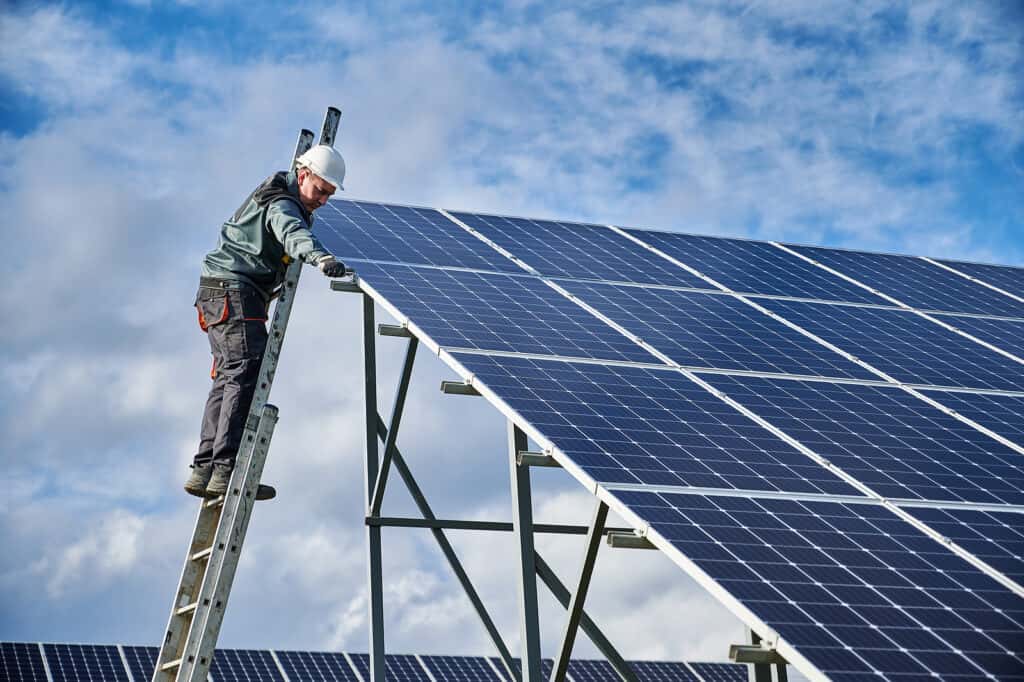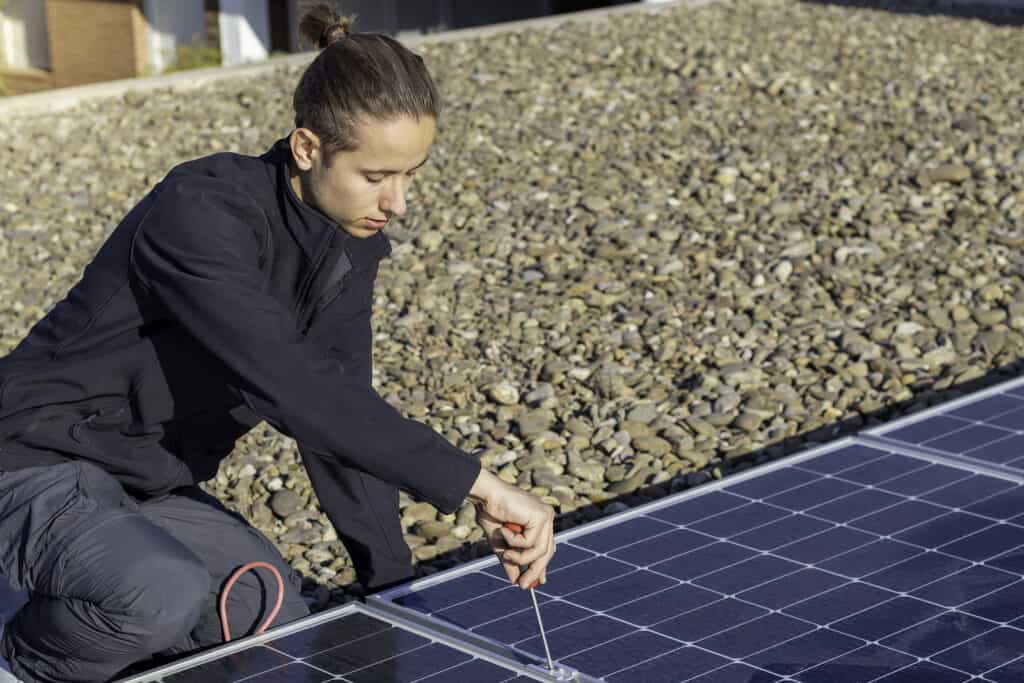As I delve into the world of sustainable and renewable energy sources, I can't help but be captivated by the immense potential of Concentrated Solar Power (CSP). This groundbreaking technology harnesses the sun's energy to produce electricity through the clever concentration of sunlight onto a small area, generating high temperatures that drive turbines.
It's truly a remarkable innovation that holds the key to a cleaner and greener energy future. In this comprehensive guide, we will embark on a journey to explore the exciting prospects of CSP, focusing on its remarkable ability to generate substantial electricity for the grid, particularly in regions blessed with abundant sunlight. So, let's dive in and uncover the bright possibilities that lie ahead!
What is Concentrated Solar Power (CSP)?
Concentrated Solar Power (CSP) is an advanced renewable energy technology that uses mirrors or lenses to concentrate sunlight onto a small area, generating high-temperature heat. This heat is then employed to power a turbine connected to an electricity generator, producing clean electricity. Unlike traditional photovoltaic solar panels, CSP systems offer the advantage of thermal energy storage, ensuring a more reliable power supply even during periods of reduced sunlight.
CSP technology's innovative approach allows for the efficient utilization of sunlight to produce electricity. By concentrating sunlight onto a receiver, where it generates high-temperature heat, CSP systems enable the generation of clean and sustainable power through turbines and generators. With its ability to store thermal energy, CSP represents a promising solution for a greener and more reliable energy future, contributing to reduced greenhouse gas emissions.

How Does Concentrated Solar Power Work?
Concentrated Solar Power (CSP) operates through a sophisticated process that harnesses the power of sunlight to produce electricity. The technology differs from traditional photovoltaic solar panels, utilizing mirrors or lenses to concentrate sunlight onto a small area, creating intense heat. Here's how CSP works:
Sunlight Concentration
CSP systems use large arrays of mirrors or lenses, called solar collectors, to precisely track the movement of the sun and concentrate its rays onto a focal point. This focal point contains a specialized receiver that absorbs and collects the concentrated solar energy.
High-Temperature Heat Generation
The concentrated sunlight on the receiver generates extremely high temperatures. Within the receiver, a heat transfer fluid, such as molten salt or a specific type of oil, captures the thermal energy from the concentrated sunlight.
Heat Transfer and Storage
The collected heat energy is transferred to a heat exchanger, where it converts water into superheated steam. This high-temperature steam can be used immediately to power a turbine and generate electricity. Alternatively, the excess heat energy can be stored in thermal storage systems for later use, ensuring continuous electricity generation even when sunlight is unavailable.
Electricity Generation
The superheated steam produced by the heat exchanger is directed towards a turbine. As the steam flows through the turbine, it causes the blades to spin, generating mechanical energy.
Electricity Production
The spinning turbine is connected to an electricity generator. As the turbine rotates, it drives the generator, converting the mechanical energy into electrical energy. This clean and sustainable electricity can be integrated into the power grid and distributed to homes, businesses, and industries.

The Types of Concentrated Solar Power Systems
Concentrated Solar Power (CSP) encompasses various system types, each employing distinct methods to concentrate sunlight effectively. These diverse CSP systems include:
Parabolic Trough
The parabolic trough system utilizes large parabolic-shaped mirrors arranged in long rows to track the sun's movement. These mirrors concentrate sunlight onto linear receivers positioned along the focal line of each trough. Within the receivers, heat transfer fluids, like specialized oils or molten salt, absorb the concentrated sunlight's thermal energy. This collected heat is then used to produce steam, which drives a turbine connected to an electricity generator, ultimately generating clean electricity.
Solar Power Tower
The solar power tower system consists of a vast field of heliostats, which are individual mirrors precisely controlled to track the sun and reflect sunlight towards a central tower. The tower houses a receiver that absorbs the concentrated sunlight and heats a working fluid, commonly molten salt or water. The heated fluid produces steam, powering turbines connected to electricity generators, enabling the production of electricity.
Fresnel Reflector
Fresnel reflector systems resemble parabolic troughs, but they utilize elongated, slightly curved mirrors, known as Fresnel reflectors. These mirrors concentrate sunlight onto linear receivers, similar to parabolic troughs. The receiver, containing a heat transfer fluid, absorbs the concentrated sunlight's thermal energy, driving a turbine to produce electricity.
Parabolic Dish
Parabolic dish systems feature a single, large parabolic-shaped reflector that precisely concentrates sunlight onto a focal point where the receiver is situated. Due to the high concentration of sunlight at the receiver, extremely high temperatures can be achieved, making this type of CSP system suitable for small-scale power generation or solar-thermal applications.

Advantages of Concentrated Solar Power
Concentrated Solar Power (CSP) offers a plethora of advantages that distinguish it from traditional fossil fuel-based energy sources and other renewable technologies. The following details highlight the key benefits of investing in CSP:
Abundant and Renewable Resource
Solar energy, harnessed through CSP, is an inexhaustible and renewable resource. With the sun's energy available abundantly, CSP can play a crucial role in mitigating climate change by significantly reducing greenhouse gas emissions and lessening humanity's dependence on finite fossil fuels.
Energy Storage Capabilities
CSP plants have a distinct advantage in incorporating thermal energy storage. This feature allows them to store excess thermal energy for later use, ensuring a stable and continuous power supply even during periods of reduced sunlight or at night. The ability to store energy addresses a major challenge faced by other renewable technologies, such as solar photovoltaic (PV) and wind power, which are inherently intermittent.
Potential for Large-Scale Generation
CSP systems are highly scalable and can be expanded to meet the energy demands of entire cities or regions. Their modular design allows for the addition of more solar collectors and thermal storage, making them versatile and adaptable to various energy needs.
Job Creation and Economic Benefits
Investing in CSP projects stimulates job creation in multiple sectors, including manufacturing, construction, and operations. The establishment and operation of CSP plants contribute to local economic growth, providing employment opportunities and bolstering regional development. Furthermore, as CSP technology advances and becomes more widespread, economies of scale are anticipated to drive down costs, rendering CSP even more economically competitive.
Environmental Benefits
CSP offers significant environmental advantages, generating electricity without emitting greenhouse gases or other harmful pollutants. By avoiding harmful emissions associated with traditional fossil fuel power plants, CSP helps mitigate climate change and enhances air quality, thereby safeguarding the environment and human health.
The Pros and Cons of Concentrated Solar Power
Concentrated Solar Power (CSP) offers numerous advantages as a renewable energy source, but it also faces certain challenges that need to be considered. Let's delve into the details of the pros and cons of CSP:
The Pros of Concentrated Solar Power
Now that we understand the mechanics of CSP, let's explore the numerous advantages it offers as a renewable energy source.
- Abundance of Solar Energy: One of the most significant advantages of CSP is that solar energy is virtually inexhaustible. The sun provides an abundant and constant supply of energy, making CSP a reliable and sustainable power generation option. As long as the sun continues to shine, we can tap into this clean energy resource.
- Energy Storage Capability: Unlike some other renewable energy sources like wind or photovoltaic solar, CSP has the advantage of energy storage capability. Many CSP systems incorporate thermal energy storage, using materials like molten salt to store excess energy produced during peak sunlight hours. This stored energy can be used to generate electricity during periods of low sunlight or even at night, enhancing grid stability and power availability.
- High Efficiency and Scalability: Concentrated solar power systems have demonstrated high levels of efficiency in converting sunlight into electricity. This efficiency, combined with the scalability of CSP plants, makes them suitable for both large-scale utility projects and smaller, off-grid applications. The modular nature of CSP systems allows for easy expansion as energy demands grow.
- Minimal Environmental Impact: Compared to conventional fossil fuel-based power plants, CSP has a significantly lower environmental impact. It produces zero greenhouse gas emissions during the electricity generation process, helping to combat climate change and reduce air pollution. Additionally, CSP plants can be built on non-agricultural land, minimizing the impact on food production.
- Technological Advancements: The technology behind concentrated solar power continues to evolve, driven by ongoing research and development efforts. As advancements are made, CSP systems are becoming more efficient, cost-effective, and reliable. This bodes well for the future of CSP as a viable alternative to traditional energy sources.
The Cons of Concentrated Solar Power
Despite its many advantages, concentrated solar power also faces several challenges that need to be considered when evaluating its viability as an investment.
- Land and Water Requirements: CSP plants typically require a significant amount of land to accommodate the mirrors, heliostats, or parabolic dishes. Large-scale CSP projects may occupy vast areas of land, potentially leading to concerns about land use and habitat disruption. Additionally, some CSP systems use water for cooling or cleaning mirrors, raising concerns about water consumption in arid regions.
- Intermittent Nature: CSP relies heavily on sunlight availability, which means that its electricity generation is intermittent and dependent on weather conditions. Cloudy or overcast days can significantly impact power output, making CSP less predictable compared to traditional power plants.
- High Initial Investment: The initial capital investment required for building a concentrated solar power plant can be substantial. While the long-term operational costs are relatively low, the high upfront expenses may deter some investors from committing to CSP projects.
- Environmental Impact during Construction: The construction phase of CSP plants may have some environmental impacts, such as soil disturbance and potential disruption of local ecosystems. However, these impacts are generally short-term, and proper planning and mitigation measures can help minimize them.
Where to Get Concentrated Solar Power
As the demand for sustainable energy solutions continues to rise, several prominent companies and organizations are actively engaged in the development and implementation of concentrated solar power projects. These players in the CSP industry include:
Abengoa Solar
A pioneering Spanish company at the forefront of CSP technology, Abengoa Solar is renowned for its involvement in some of the world's largest and most significant CSP plants. Their expertise and innovation have contributed significantly to the advancement of concentrated solar power on a global scale.
BrightSource Energy
Recognized for its cutting-edge solar power tower technology, BrightSource Energy has played a vital role in various CSP projects worldwide. Their solar power tower systems utilize a field of heliostats to reflect sunlight onto a central receiver atop a tower, harnessing concentrated solar energy for electricity generation.
SolarReserve
SolarReserve specializes in CSP projects with integrated thermal energy storage, offering a unique advantage of providing dispatchable and reliable renewable energy. The company's innovative storage solutions enable CSP plants to store excess thermal energy, ensuring continuous power generation even when sunlight is unavailable.
ACWA Power
ACWA Power is a prominent player in the renewable energy sector, involved in various energy projects, including concentrated solar power plants. Their diversified portfolio and global presence have contributed to the expansion of renewable energy infrastructure, including CSP projects.
eSolar
With a distinctive approach to CSP, eSolar utilizes small, mass-produced heliostats in their solar power plants, allowing for scalability and cost-effectiveness. Their innovative technology offers flexibility in design and deployment, making CSP more accessible and adaptable for different applications.
Frequently Asked Questions (FAQs) About Concentrated Solar Power (CSP)
1. What is Concentrated Solar Power (CSP)?
Concentrated Solar Power, or CSP, is a renewable energy technology that uses mirrors or lenses to concentrate sunlight onto a small area. This concentrated sunlight generates high-temperature heat, which is used to produce electricity through a turbine connected to a generator.
2. How does Concentrated Solar Power work?
CSP systems work by using solar collectors to concentrate sunlight onto a focal point. The three primary types of collectors used in CSP are parabolic troughs, solar power towers, and parabolic dish systems. The heat generated from the concentrated sunlight is used to produce high-pressure steam, which drives a turbine connected to a generator, generating electricity.
3. What are the advantages of investing in Concentrated Solar Power?
Investing in CSP offers several advantages, including:
- Abundant and renewable resource: Solar energy is an infinite and clean resource.
- Energy storage capabilities: CSP plants can incorporate thermal energy storage, providing a stable power supply even during non-sunny periods.
- Potential for large-scale generation: CSP plants can be scaled up to meet the energy demands of entire cities or regions.
- Job creation and economic benefits: CSP projects can contribute to local economic growth and job creation.
- Environmental benefits: CSP generates electricity without emitting greenhouse gases or harmful pollutants.
4. What is thermal energy storage in CSP systems?
Thermal energy storage is a crucial feature of CSP technology. It allows excess heat generated during sunny periods to be stored and used for electricity generation during cloudy days or at night when the sun is not available. Common storage mediums include molten salt, concrete, and thermal oil.
5. Where can I find Concentrated Solar Power installations?
CSP technology has been adopted in various countries worldwide. Some regions with notable CSP installations include the United States, Spain, the United Arab Emirates, Australia, and South Africa. However, it is essential to conduct thorough research and consult with experts for the most up-to-date information on CSP projects and investment opportunities.
6. What are the environmental benefits of CSP?
CSP generates electricity without emitting greenhouse gases or other harmful pollutants, making it an environmentally friendly alternative to fossil fuel-based energy sources. By reducing greenhouse gas emissions, CSP helps combat climate change and improves air quality.
7. How reliable is CSP as a source of electricity?
CSP offers reliable power generation, especially when thermal energy storage is incorporated. The ability to store excess heat allows CSP plants to provide a continuous power supply, even during periods of low sunlight, making it more reliable than some other renewable energy technologies.
8. Is CSP cost-effective compared to other renewable energy sources?
The cost-effectiveness of CSP depends on various factors, including location, project scale, and technological advancements. While the initial costs of CSP projects can be higher than some other renewable options, ongoing advancements and increased deployment are expected to drive costs down, making CSP more competitive in the long term.
9. Are there any challenges associated with CSP technology?
CSP technology does face some challenges, such as the need for ample land area for large-scale installations and potential water usage for cooling systems. Additionally, the availability of consistent direct sunlight is essential for optimal performance.
10. How can I get involved in CSP investment opportunities?
If you're interested in investing in CSP projects, it is advisable to research and reach out to renewable energy companies, financial institutions, or government agencies involved in CSP development. Consult with experts and financial advisors to explore suitable investment options based on your goals and risk tolerance.
Conclusion
As I conclude this exploration into the captivating world of Concentrated Solar Power (CSP), I am filled with hope and excitement for the possibilities it holds in shaping a cleaner and greener energy future. The innovative technology of CSP, harnessing the boundless energy of the sun, has shown us a path towards sustainable power generation, reducing our dependence on finite fossil fuels and combating climate change.
Delving into the mechanics of CSP, I discovered its unique ability to efficiently convert sunlight into electricity through a process of concentration and thermal energy storage. Unlike other renewable sources, CSP's ability to store excess energy ensures a stable power supply, even during cloudy days or when the sun sets, making it a dependable energy option.
Sources
https://www.energy.gov/eere/solar/concentrating-solar-thermal-power-basics
https://www.sciencedirect.com/topics/engineering/concentrated-solar-power
https://www.solarpaces.org/how-csp-works/
https://www.bbvaopenmind.com/en/technology/innovation/pros-and-cons-concentrated-solar-power/

